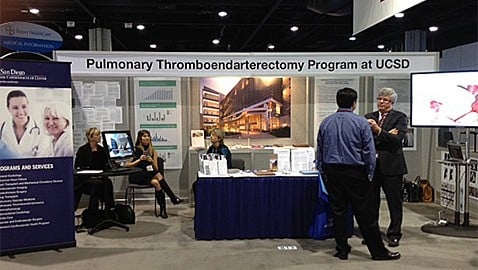The pulmonary thromboendarterectomy procedure was developed at UCSD in 1970
As of Oct. 16, surgeons at the UCSD Health System performed their 3,000th pulmonary thromboendarterectomy, a life-saving surgery developed by the UCSD Medical Center in 1970.
This is an important milestone for UCSD doctors because patients who require PTE surgery suffer from severe pulmonary embolism, which are small blood clots that form in the lungs. According to the Centers for Disease Control and Prevention, it typically affects 300,000 to 600,000 Americans annually, but a small minority may further develop scar tissue and chronic thromboembolic pulmonary hypertension. The condition leads to shortness of breath and, eventually, heart failure.
PTE is a procedure established by Doctor Kenneth Moser and a team of UCSD cardiothoracic surgeons to successfully clear this scar tissue.
Over the course of several hours, the patient is put on a cardiopulmonary bypass machine to clear the lungs of blood, allowing surgeons to work on the arteries. Additionally, the patient’s body is chilled to 18 degrees Celsius to protect major organs during the main part of the surgery, which places the patient under cardiac arrest. While the surgeons quickly clean out the scar tissue, the patient has zero heart and brain activity. Afterward, the patient is warmed and revived; they stay in the hospital for two weeks before being released.
Dr. Nick Kim, head of the PTE and pulmonary critical care programs, oversees the diagnosis, evaluation and aftercare of patients that come in, as well as clinical trials for improving CTEPH treatments.
“Patients can come in very short of breath, almost dying from their condition,” Kim said. “And within two weeks, they can have a new life.”
People suffering from CTEPH, as well as practitioners from Germany, France and the UK, come to learn from UCSD’s globally renowned staff.
“[The job] has its challenges, but it’s very gratifying to see these patients, who are nearly dead, come and get life-saving treatments,” Kim said. “Also, we’re very fortunate to be in an educator position where we’re actually out there teaching other programs how to diagnose and treat these patients.”
Only a few places in the world successfully carry out the difficult PTE surgery. Furthermore, as a leading expert in the field, the UCSD Medical Center reported a postoperative mortality risk of only 1 to 2 percent with its procedure, as opposed to the typical 5 to 7 percent, depending on a center’s experience. This is attributed to the high volume of patients that our doctors see, allowing them to perfect their methods. UCSD is responsible for the vast majority of the total PTE surgeries ever performed, often taking in sicker, more challenging patients that were turned down by other centers.
UCSD’s PTE program was th e first to be a nationally designated Center of Excellence by the American College of Chest Physicians.
“UCSD should take great pride because this is a surgery that was pioneered here in our backyard,” Kim said. “There’s a lot of local prestige and reputation that comes with being leaders in this disease.”









Marshall @ Heart Surgery India • Nov 27, 2013 at 8:09 pm
I salute all the UCSD surgeons for doing a successful operation for patients who suffers from near death situation of pulmonary embolism. We know that this is a complex surgery and it can only be performed in selected centres, and without any expertise this would hardly be triumphant. This is a testament how surgical techniques nowadays could be surprisingly advanced and how surgeons today have improved operative techniques. Kudos to the team!